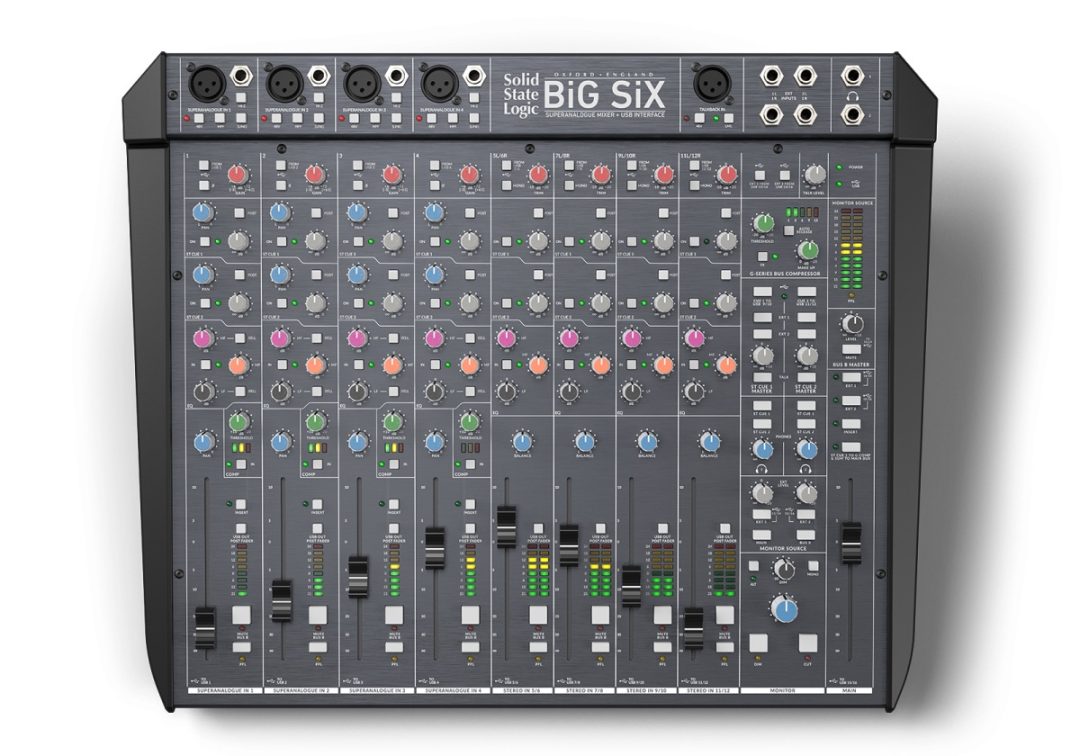To audio engineers and producers, few names resonate as profoundly as Solid State Logic (SSL). For decades, this pioneering brand has been at the forefront of shaping the soundscape of contemporary music, leaving an indelible mark on the industry with its cutting-edge technology and uncompromising commitment to sonic excellence. Over the last several years, SSL has taken big strides to deliver its renowned equipment to users on a smaller scale — for those operating a home or project studio. The SSL Big Six is one such product that we’ll review.
What Is the SSL Big Six?
The Big Six by Solid State Logic is an 18-input desktop mixer which doubles as a 16-in/16-out USB audio interface. Major features include four SuperAnalogue preamps, per-channel compression and E Series EQ, and even a famed G Series bus compressor.
- RELATED: SSL Vocalstrip 2 Review
- RELATED: SSL Fusion | The Vintage Drive You Need?
SSL made sure to incorporate feedback from artists, engineers, and producers before developing the Big Six, in order to ensure it was an appropriate and meaningful improvement over the original Six mixer. With that in mind, the Big Six desktop mixer is powerful and versatile tool, whether you’re a content creator taking your audio to the next level, or you’re an engineer using a hybrid workflow for multitrack recording and stem mixing.
What Are the Benefits of Using a Desktop Mixer?
Using a desktop mixer can offer several benefits for various applications. Whether you’re a musician, podcaster, content creator, or just someone who enjoys recording and editing audio, a desktop mixer can greatly enhance your audio production experience.
Some of the key benefits include multiple inputs for various sources, built-in signal processors like EQ and compression, tactile control for an “old school” feel, and in some cases, the ability to double as a USB audio interface.
When Is a Desktop Mixer Helpful?
A desktop mixer is helpful in various situations and scenarios where audio needs to be managed, controlled, and processed efficiently. Obviously this includes music production, particularly in the case of a smaller home or project studio. Desktop mixers can also be used for live productions, given that the necessary inputs don’t exceed the mixer’s capabilities.
Other ways to apply a desktop mixer like the Big Six include content creation, like podcasting or live streaming. You can easily route and sum various inputs and sources with a mixer, and then send the output to your final destination, whether that’s a recording device or to streaming software like OBS.
SSL Big Six Review: Upgrade Your Studio with This Powerful Mixer
How Does It Work?
Like any mixer, the Big Six works as a means to route, amplify, process, and sum input signals to a common output. Using a mixer in this fashion is common for live sound and content creation, in which all or most of the signal processing takes place within the mixer itself. The output then goes to a PA system or to a computer.
What’s cool about the Big Six is how it doubles as a USB audio interface for studio recording and mixing. Using it this way gives you a 16-in/16-out interface for DAW integration. You can take advantage of the Big Six’s I/O and signal processing to manipulate the sound at the recording and/or the mixdown stages.
What’s Included?
- (4) SuperAnalogue microphone preamps
- (4) SSL compressors
- SSL E Series equalization
- Built-in G Series bus compressor with fixed ratio (4:1), attack (30ms), and release (100ms)
- Talkback microphone with SSL’s famed Listen Mic Compressor (LMC)
- Dual headphone outputs
- Full-sized, console-grade faders
Price
Desktop mixer classification implies small form factor, and in turn, more affordable pricing relative to a larger piece of equipment. While that’s typically the case, the SSL’s feature set demands a higher price tag than a lot of comparable mixers.
At $2999, the Big Six is an investment. However, it’s worth noting that the premium analog SSL front-end is phenomenal for recording, and the included G bus compressor is practically worth the cost alone. There are a ton of professional-grade additions in the Big Six, which is why the cost is higher than you might expect for a desktop mixer.
How Does the Big Six Sound?
Everything on the Big Six derives from SSL’s legendary large-format recording and mixing consoles. To that end, this thing offers authentic SSL sound at a price that’s actually attainable for a lot of people. There’s a lot of value crammed into the Big Six that firmly separates it from the competition, so if you’re looking to take your studio to the next level, this mixer can easily help you do that.
Can I Use a Desktop Mixer for Live Sound?
The Big Six offers four XLR inputs and up to eight line inputs. For live sound, the production would have to be on the smaller side. Obviously, for full band productions with numerous inputs, the Big Six wouldn’t have the capacity. However, for coffee shop or small venue installations where you’d get a lot of singer-songwriter or small ensembles, the Big Six could potentially do very well.
Our Take: Why We Think You Would Love Using the SSL Big Six
Who wouldn’t want premium SSL sound in their studio? Chances are, if you’re even considering something like the Big Six, this desktop mixer would suit you. It’s worth noting that even on a superficial level, you can “wow” clients who come into your project studio and see an SSL mixer. There’s so much prestige associated with the brand and the quality of its products. If you’re willing to take the plunge, in our review and assessment, the SSL Big Six desktop mixer just might change the way you work entirely.
